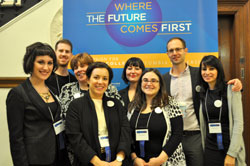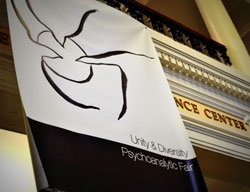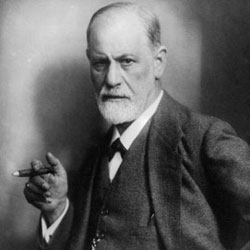Filed Under > Research/Publications
Still Living the Dream - and Explaining It
A TC gathering affirms that psychoanalysis is alive and relevant in the age of Nikeism
Feeling sad? Anxious? Depressed, shy or frightened? There’s a pill for that.
Need to talk to someone? Maybe your insurance company will cover 10 or 20 behaviorally focused sessions.
Psychoanalysis? That’s so 19th century.
Except that somebody forgot to tell the 500 people – including prominent psychoanalysts and representatives from 33 psychoanalytic training institutes – who descended on TC’s Cowin Conference Center in early February for the world’s first-ever Psychoanalytic Fair.
“Psychoanalysis is more critical now than ever,” said Frank Summer, President of the American Psychological Association’s Division of Psychoanalysis, who argued that America today is ruled by “Nikeism,” a mindset that glorifies the modern imperative to “just do it” and devalues feelings as weaknesses. “We offer a dialogue about human experience that has an attitude of exploration and contemplation.”
Jamieson Webster, a psychoanalyst in private practice in New York City and a faculty member at the Eugene Lange College at the New School, put it more succinctly: “People are crying out for something more than lab rats and materialism.”
The very fact of the Psychoanalytic Fair suggests the field’s resurgence, buoyed by an unprecedented unity in its ranks.
“Never before have the psychoanalytic institutes gathered together under the same roof in such an ecumenical spirit,” said Aurélie Athan, the Fair’s co-creator and director of TC’s MA program in Clinical Psychology. Athan cited the observation by John Gedo, past president of the Chicago Psychoanalytic Society, that “the intellectual history of psychoanalysis over the past generation can equally well be described as a chronicle about a discipline breaking into irreconcilable fragments under the impact of underlying philosophical difference or one about the emergence of a new paradigm that transcends the differences of opinion of the preceding era.”
Unity was clearly the order of the day in 1909 when Sigmund Freud arrived in New York City for his first and only U.S. visit. By his death in 1939, psychoanalysis was firmly rooted in America as a new treatment method, and The New York Times was calling Freud “the most effective disturber of complacency in our time.”
But many of Freud’s disciples later broke with the founder and each other. Hundreds of training institutes arose, comprising a range of approaches, and often their leaders feuded or simply ignored one another. Meanwhile, the field stood at a rarefied remove from many who might have sought to become practitioners, with analytic training, in the 1950s and 60s, limited to those with medical degrees.
By the 1990s, however, most institutes were open to those with Ph.D.s, J.D.s, and those with clinical degrees. Five years ago, the State of New York created the L.P., or “Licensed Psychoanalyst”, opening the field still further.
Today, many institutes accept applicants who have a master’s degree in any subject. These programs available for those without a license-eligible degree now lead to licensure through the L.P. designation in New York State. Those already with a clinical license such as social work or clinical psychology can can gain additional trainings that take from as brief as a few years to as long as ten.
The Psychoanalytic Fair reflected all of these developments, coupled with a sense that, at the dawning of a new century, the field stands at a pivotal point. The Fair’s other co-creator, Marie Hansen, a TC master’s degree student in clinical psychology and founder of Cathexis, an interdisciplinary group on campus aimed at promoting psychoanalytic thought, called for “the continued transmission of psychoanalytic wisdom to the next generation” and “more bridges of communication between current and future psychoanalysts” to both “preserve and innovate the field.”
The Fair’s main event was a discussion about the continuing relevance of psychoanalysis, but it quickly became clear that the panelists viewed the question as merely rhetorical. Yes, psychoanalytic treatment can seem long and arduous, and yes, its “payoff” is typically long-term and difficult to quantify in dollars and cents. Yet the length and depth of psychoanalysis is precisely its strength, panelists argued, constituting a radical critique of our culture’s reigning ethos of speed and convenience.
Summers, for one, said he came to the field because it takes people – and not just their symptoms – seriously.
“Psychoanalysts were the only people who really helped me understand people,” he said. “The other [approaches] were superficial or just didn’t have a way of understanding. Psychoanalysis allowed me to explore the human experience in an in-depth way.”
Each of the panelists touched on the need for future analysts to be curious, challenge received wisdom and make discoveries both within themselves and others. Lewis Aron, Director of the New York University Postdoctoral Program in Psychotherapy and Psychoanalysis, said that “psychoanalytic institutes provide a community to network, learn, and thrive in the psychoanalytic tradition.” And Richard Reichbart, President-Elect and Fellow of the Institute for Psychoanalytic Training and Research, added “The motivated candidate will grapple with each theory – what they believe, and what they don’t. Analysts need an inherent desire for exploration.”
The panel discussion was followed by an information session, with tables hosted by each of the participating institutes. Athan and Hansen acknowledged the difficulty of finding one’s calling in the vast and complex field of mental health – a task not unlike the psychoanalytic pursuit of deeper truth. Thanks to the Psychoanalytic Fair, though, that labyrinthine process of discovery is more likely to result in a classic “Aha!” moment.
Visit the Psychoanalytic Fair website for links to the various participating institutes. For a copy of the conference brochure, email Aurelie Athan at ama81@columbia.edu.
Former newspaper reporter MATTHEW BLANCHARD, M.A. is a second-year Ph.D. student in Clinical Psychology at Teachers College. He is the department’s Adjunct Faculty Liaison, an academic advisor to MA students, and co-coordinator of the Concentration in Psychotherapy and Psychoanalysis. He ponders the mysteries of transference every weekday as a therapist at the Dean Hope Center for Educational and Psychological Services and a psychotherapy researcher with Dr. Barry Farber. He served as the Moderator in the Psychoanalytic Fair.
KATELYN ZMIGRODSKI is pursuing a master’s degree in the Psychology in Education Program, where she is also concentrating in Psychotherapy and Psychoanalytic Perspectives. Her interests include the history and contemporary practice of psychoanalysis, as well as informing MA Students about additional avenues of training. She served as the Psychoanalytic Fair reporter.
Published Monday, Feb. 24, 2014


